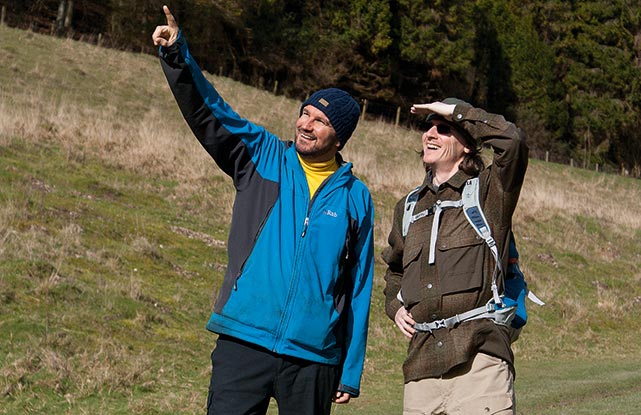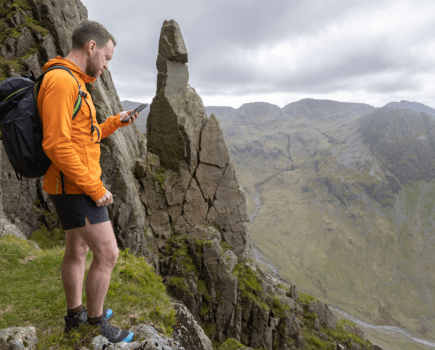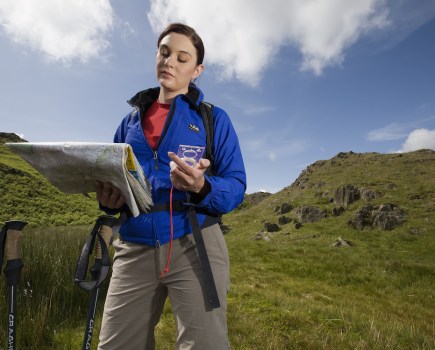The Irish stand-up heads to the South Downs for a navigational treasure-hunt, and picks up some fascinating tips from ‘Natural Navigator’ Tristan Gooley
I meet Tristan Gooley in a small cafe in the Lord of the Rings-sounding town of Arundel in the South Downs. Tristan has carved a name for himself as the go-to guy in the rather niche study of natural navigation. With three books to his name and the latest (The Walker’s Guide to Outdoor Clues and Signs) on its way, what he doesn’t know about finding your way unaided by map, compass or GPS isn’t worth knowing. Considering his predilection for all things natural, and knowing he’s honed his skills travelling with the Bedouin and Tuareg peoples, I half expect to be greeted by a man dressed in an outfit he has fashioned himself from hemp and bulrushes, but instead a surprisingly regular dude greets me by the door of The Edible Sandwich Bar.
Not five minutes walk from the café, Tristan demonstrates how many things there are around us that can give us navigational clues. Just as with normal navigation using a map and compass, it’s all about gathering as much information as possible to confirm in which direction one should be heading. The main clues come from the sun. “What direction is the sun shining from at midday?” asks Tristan. “I know this one,” I think to myself, just before blurting out the wrong answer: “Directly above.” “No…” replies Tristan patiently. “In this part of the world it’s always due south.” As soon as he says it I remember that this is the case. And it’s just as well it is. The southerly position of the sun affects the growth of so many plants that it turns the land into a giant compass.
The first such indicator Tristan points out is a lichen called xanthoria. While most lichens are grey/green, xanthoria is a more vivid rust colour and it only grows on south-facing surfaces. And there, on some fencing right in front of us, is orange lichen indicating our way south. Tristan then gestures to the area of gardens enclosed by the fence and asks if I’ve noticed anything about the way the flowers are pointing. Sure enough, the majority are leaning in one direction: south. “That is because flowers grow towards the light,” he explains. “Phototropism,” I say, proudly pulling on what little knowledge I gained from my time studying horticulture before laziness and insecurity drew me away from academia and towards the stage. “That’s right, phototropism.” Tristan nods, mildly impressed. I feel I’ve gone some way towards making up for forgetting that the sun is always to the south at midday.
While the courses Tristan runs and the books he writes are centred around using the natural world to help you orient yourself, it would be foolish not to also point out some of the ‘less natural’ cues at our disposal. To that end, as we are still in Arundel at this point, he turns my attention to the satellite dish attached to the roof above us. He then tells me something I already knew but which I never realised I would find useful: all satellite dishes (with the exception of specialist equipment, as opposed to ordinary consumer models) point to the same geostationery satellite. That means – give or take a couple of degrees depending on where you are in the country – that they all point midway between south-east and south-south-east.
This is a handy tip if you’re in a built-up area and a bit unsure of your direction. Now, obviously, some would say, if you’re in an area of civilisation and it was that important, you could just ask for directions. But that’s a bit like saying: “Why are you carrying flint, steel and tinder when you could just carry a lighter?” It slightly misses the point. Also, I am a bloke and therefore don’t like asking directions even in an emergency.
The theme of using the built environment as a navigational aid continues when we enter a quiet residential street and Tristan asks if I can tell in which direction the centre of town is. I look at the numbers on the doors of the houses (even on one side, odd on the other) and suggest that the numbers go up as you get away from the centre. I’m not entirely sure that this is true but Tristan confirms that I’m correct. That whole “sun being directly above us at midday” nonsense must be forgotten by now, I think. Again, this isn’t a hard and fast rule and in more suburban areas can pretty much be thrown out the window, but it’s a handy guide. Then, in a moment of serendipity usually reserved for romantic movies, a couple of tourists approach us and ask us for directions to the centre of town. With great aplomb I gesture towards the lower numbered end. Fortunately, the temptation to point out the house numbers to them in a “teach a man to fish” type way is luckily trumped by my not wanting to look like a smartarse.
Another architectural clue to compass points comes as we enter a churchyard. Here Tristan gives me a lesson that is geographical, historical and theological all at the same time. Churches – older, more traditional ones at least – are aligned east/west with the altar at the eastern end. The southern side is considered the more holy and so the main entrance is usually to the south of the building, as is the bulk of the church’s graveyard. Bodies were generally buried there and only later were more interred around the east and west. There is normally a smaller graveyard on the north, which would have originally been for those people who weren’t bound for heaven – such as the unbaptised, the divorced and, I suppose, people who use the word “literally” in a figurative sense. As demand for space increased, more devout people would eventually end up buried on the north side also, so this would be where newer graves could be found. Incidentally, at this particular church, all the graves, and the church walls, have xanthoria growing on their southfacing sides – which is so navigationally handy that the old churchyard may as well have been manufactured by Silva.
As we head out of the town and into the countryside, Tristan points out a few more natural compasses in the form of trees. Again, this comes from the fact that the sun is always to the south so trees tend to be bushier on their south sides. They may grow generally straight up but, if they’re deciduous, the pattern of branches indicates the direction of south. Branches on the north side grow in an upward tick as if trying to point back into the tree, while south-facing branches grow away from the tree towards the sun. Once it’s been pointed out to you, it’s hard not to notice. Looking from a decent vantage point at a field or meadow dotted with deciduous trees they all look like they’re pointing accusingly at some unseen suspect to their southern side.
In the two hours that I spend with Tristan he tells me countless tidbits of information – from the dependence of nettles on civilisation to the effect of wear on a holly bush’s prickles; from how wind direction affects the shape of a tree’s base to how the colour of the sky around the sun changes depending on your proximity to industrialisation. Ultimately, if you’re the sort of person who reads The Great Outdoors, it’s unlikely you’ll ever need any of this information. You, like me, pack a map and compass when setting out. But, as I said before, looking at the topic that way slightly misses the point. Even if your life doesn’t depend on being able to find south without a compass, looking out for these clues makes for a more rewarding experience when you’re out in the hills. Understanding why the things around you, both natural and man-made, are arranged the way they are, gives you a better appreciation of your surroundings, which can only be a good thing. Getting to look like a smartarse in front of the rest of your walking mates is the icing on the cake.
Words: Ed Byrne
Photos: Geoff Barton
FIVE HANDY OUTDOOR CLUES AND SIGNS FROM TRISTAN GOOLEY
[1] There are dozens of ways that plants reveal direction and the simplest is that they grow more abundantly on the sunnier southern side.
[2] It’s not just plants; anything that has a relationship with the sun will give clues to direction. There are many manmade examples: solar panels, sundials and roof shapes can all indicate south for you.
[3] The wind comes from the south-west more frequently than any other direction in the UK. This leaves telltale clues everywhere: the tops of trees, buildings and even, with a lot of practice, in blades of grass and puddles.
[4] Wherever any minor path meets a major one, there will be clues in the tracks on the ground to the most popular direction people turn. This is usually a good sign towards civilisation.
[5] All plants are indicators of something. Stinging nettles only grow in phosphate-rich places and this is a sign of habitation. Towards the end of a walk, stinging nettles are usually a clue that the pub is not far away now.








